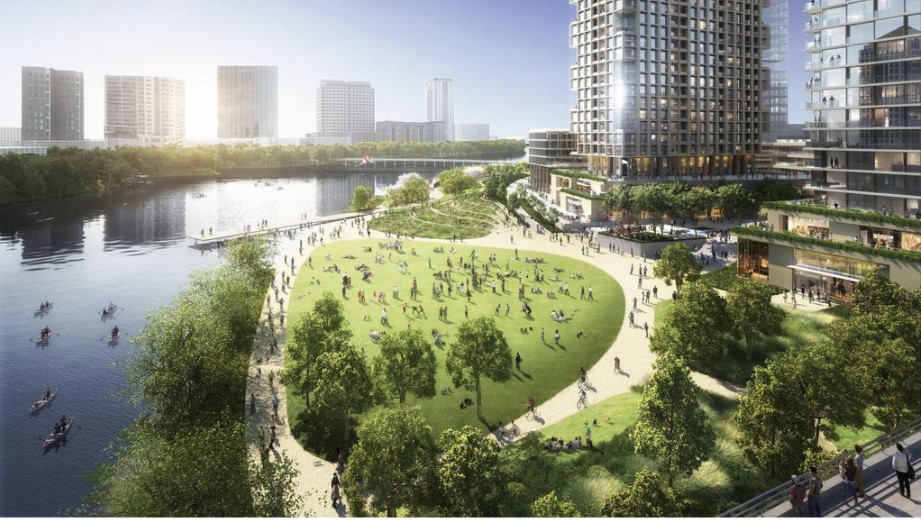Massive redevelopment of Statesman site makes it to Austin Planning Commission

After many years of planning, the proposed transformation of the Austin American-Statesman property just outside downtown Austin is coming back into focus at the municipal level.
The highly anticipated redevelopment, which would span about 19 acres along Lady Bird Lake, was considered into the late hours of the evening on Dec. 14 by the Austin Planning Commission. Endeavor Real Estate Group LLC — developer of Southpark Meadows and The Domain — is leading redevelopment of the tract, which is part of the city’s wider South Central Waterfront Initiative that envisions dense, mixed-use development along the water.
Transformation of the Statesman site may include up to 1,378 residential units, a 275-room hotel, 1.5 million square feet of office space and 150,000 square feet of commercial and restaurant space, according to city documents. That could result in twice as much square footage as Barton Creek Square mall and a high-rise or two taller than the Frost Bank Tower.
Other priorities include reconstruction of 1,700 feet of the Ann and Roy Butler Hike and Bike Trail along the waterfront and enhancing the area under the Congress Avenue Bridge where people often gather to watch the world’s largest urban bat colony take flight.
The complex proposal merited a robust conversation at the meeting, which ultimately led to postponement to allow more time for commissioners to grasp the project details. In late January, the Planning Commission will also form a working group to nail down project recommendations for the planned unit development.
“Now that it’s just coming to us, I want to slow the process just a little bit,” Commissioner Jennifer Mushtaler said. “We won’t get back the bat colony if we screw this up. We won’t get back water quality if we screw this up. We won’t get back green space if we screw this up.”
Some commissioners wanted to know more information about the tax increment reinvestment zone that will be used to finance the project, while others were concerned about affordable housing requirements and protecting the integrity of the trail and Lady Bird Lake. The need for an additional hotel in the downtown vicinity was also questioned at the meeting.
Richard Suttle, land use attorney with Armbrust & Brown PLLC and representative for the developer, told commissioners that the plan isn’t set in stone and that the team is open to commissioners’ suggestions.
“We’ll try to incorporate all of the recommendations that we can, while keeping in mind that we have to have a viable project,” Suttle said. “There’s lots to work with, and we’re confident that we can earn your recommendation.”
Under the current proposal, 4% of residential space, 55 units, would be dedicated to affordable housing, or the developer would pay fees-in-lieu for affordable owner-occupied housing, Planning and Zoning Department leader Jerry Rusthoven said at the meeting. That percentage of affordable housing is a little lower than usual because of the amount of parkland and right-of-ways that the developer has agreed to give up under the 2016 South Central Waterfront Initiative, Rusthoven said. One-third of the overall tract will be dedicated parkland, and the developer will also dedicate property to a transit stop for the future $7.1 billion Project Connect plan.
The city’s South Central Waterfront plan covers 118 acres and 32 private properties situated along the south shore of Lady Bird Lake. The plan was adopted by Austin City Council in 2016 and calls for creating walkable environments, expanding open spaces and maintaining affordable housing. The fledgling Austin Economic Development Corp. has been tasked to help manage the initiative.
The financial backbone of the South Central Waterfront plan is still in the works. City Council will consider creating a tax increment reinvestment zone, or TIRZ, at a special called meeting on Dec. 20. Tax increment financing is a tool municipal governments use to finance redevelopment projects using future tax revenue from new development.
“We won’t build the plan if there’s no TIRZ,” Suttle said during the meeting.
The entire South Central Waterfront plan could cost $252 million, according to city documents, and a TIRZ could cover a large portion of that cost. Other Austin projects such as the Waller Creek Tunnel and Mueller have benefitted from tax increment financing districts.
The Statesman site, located at 305 S. Congress Ave., is owned by the Cox family, which bought it from their namesake newspaper chain, Cox Media Group, in 2015. Endeavor was hired as master developer in early 2017 and Chicago-based architecture and urban planning firm Skidmore Owings & Merrill LLP is leading design efforts.
Suttle played a video of the planned project during the commission meeting that can be viewed at the 2 hour, 20 minute mark here.